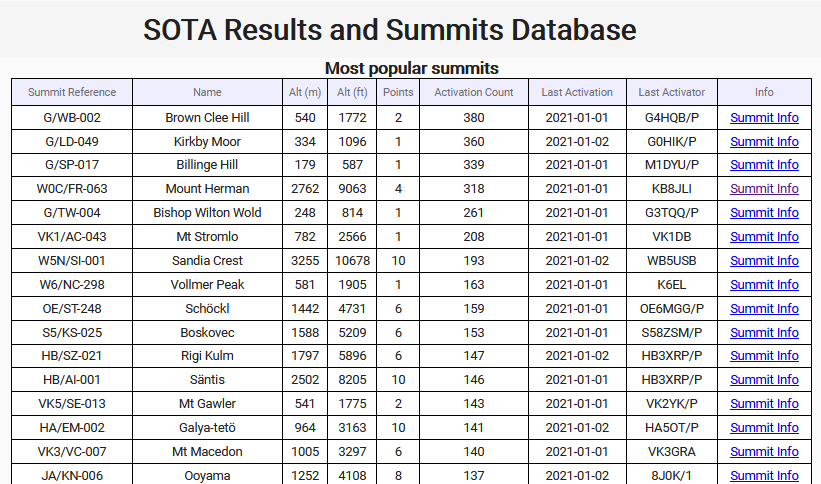The Most Popular Summits Page seems to be really confused.
That is, it is not listing the correct summits.
https://www.sotadata.org.uk/en/summit/top
Hi Bob,
I’m sure someone from the MT will respond, but what do you see as being wrong?
Looking at the table, it is listing the summits in the reverse number of activations (i.e highest activation count first with G/WB-002 of 380 and then reducing down). Are you saying there are summits with more than 380 activations that are missing?
73 Ed.
If I recall correctly, this top 50 list normally begins with summits that have ~300 activations. The list I see now includes JA/KN-006 with only 137 activations. The highest number of activations shown now is G/WB-002 with 380 but I recall there are other G summits with many more activations.
Unless the definition of “Most Popular” changed.
You recall wrong, but I can understand why. The page is a direct copy of the old page, so no definition change, but its logic is pretty weird, looking at the query. It’s the most popular summits for the year, listed by total activation count ever. Given the year is only 3 days old, the list of summits activated this year is small. As things like The Cloud get activated this year, they’ll pop into the list.
I suspect the logic is written the way it is to avoid a whole table scan of the Activator Logs table, while keeping it “fresh” by only looking at summits with activations in the current year.
What? how is that relevant? If we want to show the most activated in a particular year, shouldn’t that be a different query and this query by its title infers most activated since the start of SOTA in the various associations.
I can’t see the reason to mix the two requirements up but at least we know what is going on now, so thanks for the clarification, Andrew.
73 Ed.
I must admit, it is news to me that a summit needs to have been activated in the current year to qualify for inclusion in this list. I tend to agree with Ed that the ranking should be on number of activations only, and take no account of the most recent.
It’s been like this for years and years.
ISTR it’s a way of only selecting summits which are being activated and then listing by popularity. I had to go and look at the source to see how it worked. Using logic to select only summits this year (i.e. 2021) gives a different feel to the table when the year changes and a better way would be to select the date range for the last 365 days not current calendar year. There would not be such a jarring change.
It also means that only summits which are valid appear in the list, well for a calendar year.
There are plenty of ways to skin a cat but as this cat skinning method hasn’t changed for years and nobody has ever noticed till now that the logic is not what they expect, then it probably is as valid as the next idea.
That’s where I would be going. I think the logic has been taken purely to avoid a big query, but with careful indexing it shouldn’t be an issue. The data that is returned is all stored as part of the summit table, such as last activation, and activation count. Thus, the query doesn’t need to scan the Activations table, which was probably an expensive query on a shared host in 2004, index or not.
Thanks, that explains it.
Now I wonder why I never noticed this before. I look at this page every once in a while to see what US summits have made the list. Apparently, I did not look at it in early January before. A few months into the year and most popular summits will all be activated and the effect of “activated this year” will fade.
It would be good if the page had a sentence or two explaining the algorithm.
Sorry for awakening an old thread. Assuming the logic behind this page hasn’t changed since January I suggest the title should be “Most popular summits this year” and the column header should be “All Time Activation Count”. This makes it clear and so will avoid a new thread on 3 Jan 2022.
